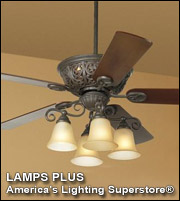Ceiling Fans
 Ceiling fans have become much more technologically advanced and appealing. They are often a large part of a home's décor. They help to cool the home in the summer and warm it in the winter. Ceiling fans can reduce your energy cost by 40% in the summer and 10% in the winter. Fans are used throughout the home in main rooms, kitchens, bathrooms, verandas, patios, and etc. They add to the rooms appeal and lower dampness.
Ceiling fans have become much more technologically advanced and appealing. They are often a large part of a home's décor. They help to cool the home in the summer and warm it in the winter. Ceiling fans can reduce your energy cost by 40% in the summer and 10% in the winter. Fans are used throughout the home in main rooms, kitchens, bathrooms, verandas, patios, and etc. They add to the rooms appeal and lower dampness.
Choosing the right ceiling fan
The price varies on ceiling fans based on the quality, style, and size. Check over the differences before making the purchase. If you purchase an inexpensive one, it may seem good when you first use it, but over time it will warp, become off-balance, and wear out. Choosing a good fan to start with is a better idea. You can enjoy the comfort and beauty for years. What you should look for in a fan is the quality, motor, durability, performance, design, and warranty.
Choose a fan that fits in with the style of your home and room that suits your taste. There are many colors, finishes, blade designs, sizes, accessories, lighting, and styles to pick from. Options to choose from are polished brass, antique brass, iron, copper, nickel, pewter, chrome, black, vibrant colors, oak, rosewood, and other real wood veneers.
Details to consider before choosing a new fan for your home:
Fan Size:
To utilize the most efficiency the fan needs to fit the size of the room. A general rule to follow is 29" to 36" fan diameter for a room up to 75 square feet, 36" to 42" for rooms up to 144 square feet, and 50" to 54" for rooms up to 225 square feet.
Height from the ceiling:
The fan should be more than 7 feet over the floor in the middle of a room to get the most comfort, circulation, safety, and décor from it. The best height is 8 to 9 feet from the floor.
Blades:
The blades create the circulation, so their position is very important. The blade brackets should hold the blades at a 12-15 degree angle. The weight of all blades should be the same. This allows optimum circulation and avoids fan wobble. Less than 12-degrees on the angle will lower the circulation, higher will increase it. Be sure the blades are wood or acrylic with moisture treatment to avoid warping.
Motor:
The motor is the most important part of the ceiling fan. A high-quality motor should have heavy-duty windings and sealed bearings with permanent lubrication. This will insure quiet operation and long life.
Lights:
Lights on a ceiling fan can add to your décor and create the final touch to your room lighting. There are various styles of lights to choose from on ceiling fans. They range from classic to antique to contemporary. You can also add opal, marble, crystal, glass, and hand blown glass on the fitter, shades, or votives. You can often choose a fan and light kit separately to satisfy your taste and compliment your room's décor. You can also choose between up and down lighting to add ambiance to rooms like your living or bedroom.
Finish:
To avoid blistering, fading, corrosion, and tarnishing, be sure that the blades have a high quality finish. If they are not high quality, the blades will quickly peel, bubble, or corrode. The main finishes are brass and wood. Brass is long lasting and scratch resistant does not need polishing and the painted finishes are thick and durable when properly coated.
Warranty:
A good warranty is always the best option. If you choose your fan carefully, you will find that many manufacturers with high quality fans offer a lifetime warranty and even in-home service.
Installation:
You can usually install a ceiling fan on your own. The installation is not difficult and the fans come with step-by-step instructions. Support systems are normally provided to allow hands free wiring. Just be sure the fan and home wiring is compatible.
Cost:
You can expect to pay $135 to $425 for a good quality fan. The price will vary from manufacturer to manufacturer and depending on the ceiling fan's features. The old saying "you get what you pay for" definitely applies to ceiling fans.



.png)
.png)


